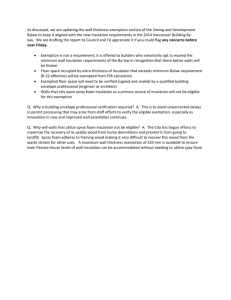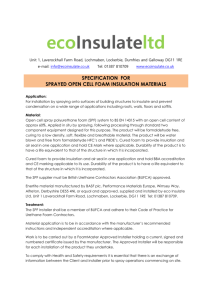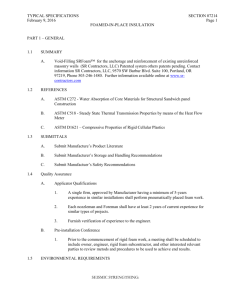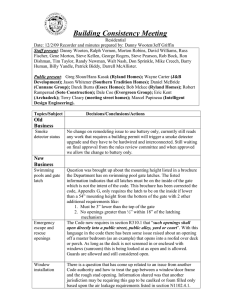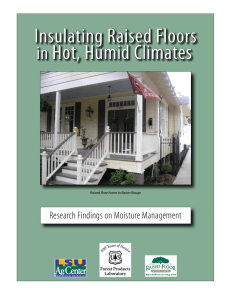Building Consistency Meeting
advertisement
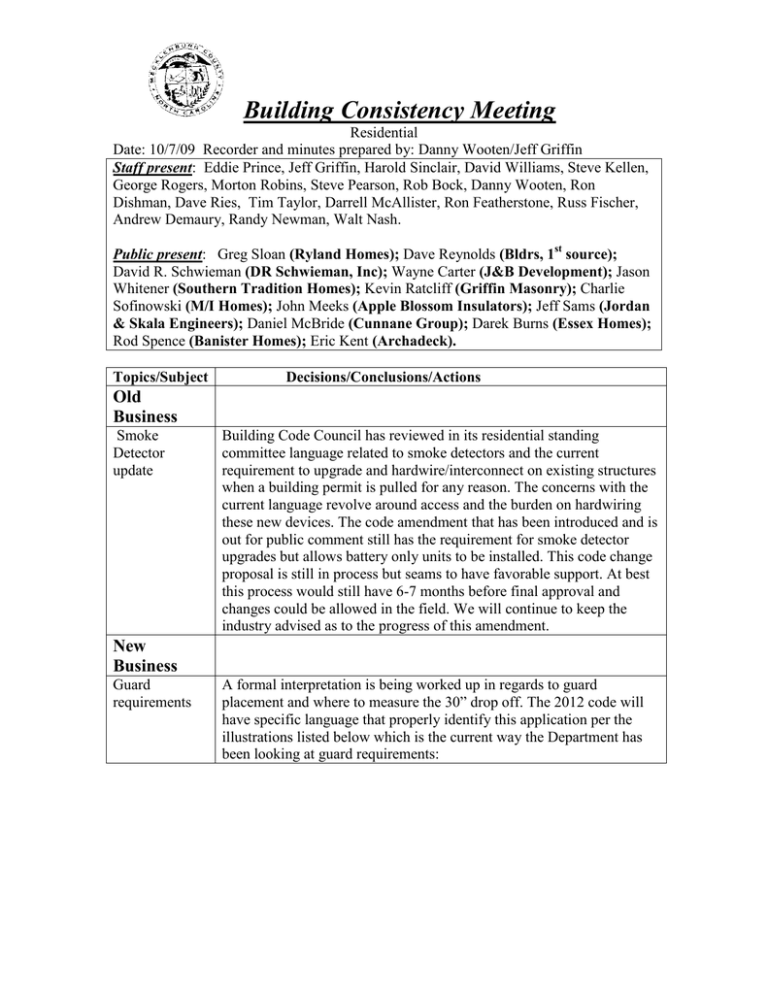
Building Consistency Meeting Residential Date: 10/7/09 Recorder and minutes prepared by: Danny Wooten/Jeff Griffin Staff present: Eddie Prince, Jeff Griffin, Harold Sinclair, David Williams, Steve Kellen, George Rogers, Morton Robins, Steve Pearson, Rob Bock, Danny Wooten, Ron Dishman, Dave Ries, Tim Taylor, Darrell McAllister, Ron Featherstone, Russ Fischer, Andrew Demaury, Randy Newman, Walt Nash. Public present: Greg Sloan (Ryland Homes); Dave Reynolds (Bldrs, 1st source); David R. Schwieman (DR Schwieman, Inc); Wayne Carter (J&B Development); Jason Whitener (Southern Tradition Homes); Kevin Ratcliff (Griffin Masonry); Charlie Sofinowski (M/I Homes); John Meeks (Apple Blossom Insulators); Jeff Sams (Jordan & Skala Engineers); Daniel McBride (Cunnane Group); Darek Burns (Essex Homes); Rod Spence (Banister Homes); Eric Kent (Archadeck). Topics/Subject Decisions/Conclusions/Actions Old Business Smoke Detector update Building Code Council has reviewed in its residential standing committee language related to smoke detectors and the current requirement to upgrade and hardwire/interconnect on existing structures when a building permit is pulled for any reason. The concerns with the current language revolve around access and the burden on hardwiring these new devices. The code amendment that has been introduced and is out for public comment still has the requirement for smoke detector upgrades but allows battery only units to be installed. This code change proposal is still in process but seams to have favorable support. At best this process would still have 6-7 months before final approval and changes could be allowed in the field. We will continue to keep the industry advised as to the progress of this amendment. New Business Guard requirements A formal interpretation is being worked up in regards to guard placement and where to measure the 30” drop off. The 2012 code will have specific language that properly identify this application per the illustrations listed below which is the current way the Department has been looking at guard requirements: In the illustration above if fixed seating is installed as shown then guard will need to be raised to 36” above seating. The center illustration shows how to measure to elevated floor to an exterior grade, there is a 36” horizontal projection issue so if within 36” it drops more than 30” below the upper floor a guard is required. The far right illustration show a grade consideration on the side of stairs that applies that same 36” horizontal projection, if more than 30” within 36 horizontal, in this off the first tread (standing/walking surface) then a guard down that side of the stairs would be required. Foundation wall least dimension Concern brought up about a basement foundation wall adjacent to higher garage floor that started off as a 10” poured concrete wall and then transitioned to a 6” or less foundation wall for the last couple feet above the garage slab floor. The top portion of this wall that is 6” or less has the anchor bolts installed for basement walls and will support the wood floor assembly. This transition point from a 10” poured wall to less than 6” is a weak point in the wall assembly. Currently the Department will look at these application as a worse case scenario with the wall being the least dimension in thickness as if built all the way up, if that least dimension will meet the foundation table it will be allowed or the wall will need to be engineered. Crawl foundation wall with more than 48” of unbalanced fill One current concern with the language listed in the code has to do with the amount of backfill you can place against a foundation wall on a crawl space application that is not supported at the bottom end per the code in section R404.1 item #1. The language in this section along with section R404.1.3 would require on a typical crawl space that no more than 48” of unbalanced fill can be placed against these walls. If more than 48” of unbalance backfill is installed then engineering design would be required. Currently section R404.1 listing what is lateral support, which is new to the code, is in the process of being removed to allow traditional foundation installation including bolt spacing. This change has not been approved yet and if approved may be 6-9 months out. Prefab stair stringers Issue discussed concerning prefabricated stairs and the manufacturers requirement for stair stringer to be nailed to studs at 16”o.c. spacing per their installation instructions. These types of stairs cannot be placed in a situation where the stair stringer is in span but is required to be support along both sides with adjacent wall framing. Issues have come up on several jobsites, mainly in a bonus room over a garage application, where they span from landing to floor level. Manufacturer’s installation instruction on proper application and support of these factory built stairs must be followed, picture below is a sample illustration of the issue: Non-vented vaulted ceiling rafter cavities Issue discussed related to rafter cavities on a non-vented cathedral ceiling line where it is packed out with high density cellulose insulation as pictured below: The code currently doesn’t recognize this application except as a conditioned unvented attic assembly under section R806.4 with the insulation product having to meet ASTM E 283 “air-impermeable”. Cellulose has not been tested to that standard and is currently not allowed in a sealed application. All rafter cavities currently must be vented per section R806.1. Builder certificate We are currently enforcing the new requirements under the NC 2009 residential code related to a builder certificate. This is a permanent label that the builder (not the insulation company) is required to post on site at 1 of 3 approved locations at final inspection. This applies to all homes permitted on or after July 1st, 2009. The Department has worked up a sample certificate and has been spreading this information within the industry for the last year, attached below is a copy of that sample: Foam insulation in attics and crawl spaces On June 3, 2009 the International Code Council Evaluation Service Inc. held a hearing regarding the new Acceptance Criteria AC377 for Spray Applied Polyurethane Foam Insulation. During that hearing the group agreed to adopt the modified NFPA 286 room corner test as the criteria for Spray Polyurethane Foam (SPF) used in attic and crawl space applications. This ruling is effective immediately for all new spray foam insulation products requesting an ICC-ES report. All existing spray foam products can continue to be used per their current ICCES report; however the new tougher NFPA 286 test will be required at report renewal. All existing ICC-ES reports are subject to re-examination one year from the issue date. Between now and June 1, 2010, all SPF insulation products on the market today will need to meet the tougher NFPA 286 fire test for their ICC-ES reports to be renewed. Most of the existing products will meet the new fire test if they are covered with a high quality intumescent ignition barrier coating at 5 mil dry thickness. The Department has taken the stand as well as DOI that only ICC evaluation reports will be acceptable for approval of the usage of foam in attic and crawl applications.

